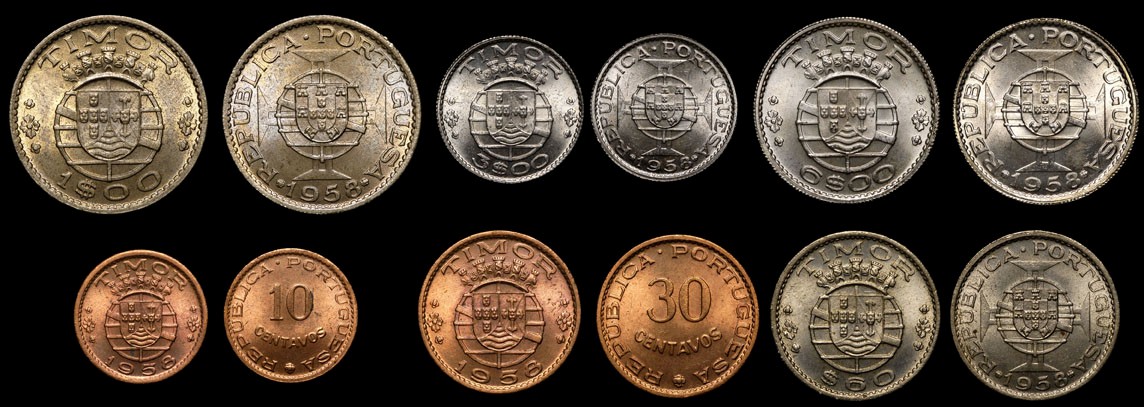World Coins: Timor
Posted on 12/19/2012
East Timor is one of the world’s newest countries, having achieved independence and nationhood in 2002. However, the coinage of Timor reaches much further back, to the time of Portuguese colonization.
The Island of Timor was discovered by the Portuguese in 1515, with the first settlements beginning in 1556. In 1702, Portugal officially made Timor a colony of that nation. The colonies of Macau, China and Timor were operated by the same administration. The sole administration lasted until 1896 when Timor became an autonomous colony from Macau, China , and was known as Portuguese Timor. In 1941, Portuguese Timor was occupied by the Australians and the Dutch. They failed to stop the Japanese invasion in 1942 and Timor (along with the Dutch colonial administration) was assigned to a single Japanese administrative zone. During the war, Timor was believed to have lost up to 60,000 people due to fighting the Japanese, famine and disease. After the war, the Portuguese quickly reclaimed Timor as their colony but lost West Timor, which became part of Indonesia in 1949.
By 1974, Portugal’s government had changed its stance on colonization and began to decolonize Africa and Asian Territories. On November 28, 1975, East Timor declared independence; however, nine days later Indonesia invaded and Timor became Indonesia’s 27th Province.
Before World War II, the colony of Timor’s circulating coinage was largely comprised of a mix of Spanish 8 Reales, Chinese Dollars, British Trade Dollars, and coins from the Netherlands East Indies, Hong Kong, China, and the Strait Settlements. During the Japanese occupation, the Netherlands Indies Gulden was introduced. In 1945, when the Portuguese reestablished their colony in Timor, they introduced the Pataca and Avos—now pegged to the Portuguese Escudo at a rate of 5.5 Escudos to a Pataca. It took 100 Avos to make one Pataca. Under this system, Timor saw its first coins issued under their own colonial name. 10 Avos coins were issued in 1945, 1948 and 1951; 20 Avos coins were issued in 1945 and 50 Avos coins containing silver were issued in 1945, 1948 and 1951.
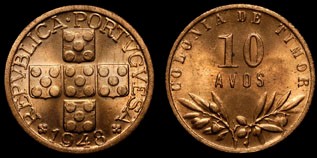
Timor 1948 10 Avos
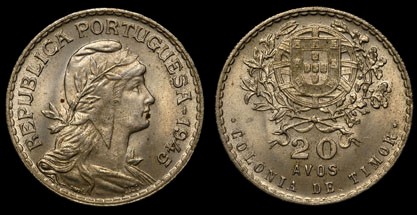
Timor 1945 20 Avos
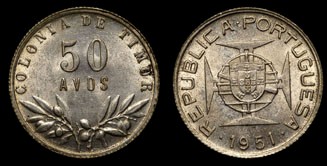
Timor 1951 50 Avos
In 1958, the money was reformed and the Pataca was replaced by the Escudo. The rate was now 1 Pataca to 5.6 Escudos. Avos were replaced with Centavos, again with 100 Centavos to one Escudos. In 1958, 10 Centavos, 30 Centavos, 60 Centavos, 1 Escudos, 3 Escudos, and 6 Escudos coins were issued.
In 1964, a 10 Escudos coin was issued. In 1970, 20 Centavos, 50 Centavos, 1 Escudos, 2-1/2 Escudos, 5 Escudos, and 10 Escudos coins were issued. When Indonesia took over Timor in 1976, these coins were replaced with issues of Indonesia.
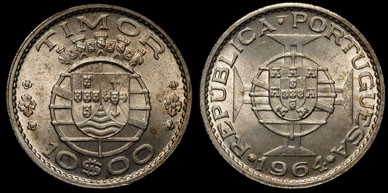
Timor 1964 10 Escudos
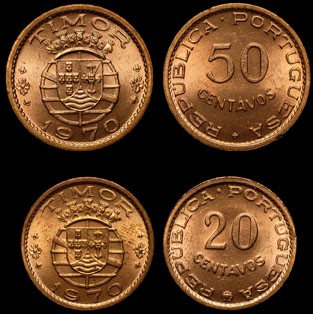
Timor 1970 20 Centavos and 50 Centavos
While new coins of East Timor (now independent from Indonesia) are being made today, the coins of Portuguese Colonial Timor are heavily collected by those who also collect Portuguese coins, colonial coins, Asian coins, and other types. While it represents a relatively small set to complete, it can be very difficult since many pieces have mintages of less then a million. The 1945 10 and 20 Avos have mintages of only 50,000 each, making them very difficult to find, especially in higher grade. If you want a historically significant challenge that you can complete with a little hard work and some searching, this might be a set to try.
Stay Informed
Want news like this delivered to your inbox once a month? Subscribe to the free NGC eNewsletter today!
